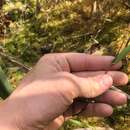Comprehensive Description
provided by North American Flora
Panicum verrucosum Muhl. Descr. Gram. 113. 1817
Panicum debile Ell. Bot. S. C. & Ga. 1: 129. 1816. Not P. debile Desf. 1798. Panicum umbraculum Bosc; Spreng. Syst. 1: 314, as synonym. 1825. Panicum rugosum Bosc; Spreng. Syst. 1: 314, as synonym. 1825.
Plants bright-green, solitary or few together, lax, at first erect but soon decumbent at base, and ascending or widely spreading; culms slender, 20-150 cm. high; leaf-sheaths shorter than the internodes, ciliate; blades thin, lax, flat, 5-20 cm. long, 4-10 mm. wide, somewhat narrowed toward the base, gradually narrowed to the acuminate apex, glabrous; panicles finally exserted, 5-30 cm. long, about as wide, diffuse, small panicles often produced at the lower nodes, at least the ultimate branchlets scabrous, the branches mostly solitary, the branchlets bearing a few short-pediceled spikelets, mostly in twos, toward the ends; spikelets 1.8-2.1 mm. long, about 1 mm. wide, elliptic-obovate, subacute; first glume one fourth the length of the spikelet or less; second glume and sterile lemma warty, glabrous, the glume shorter than the fruit at maturity; fruit 1.8-2 mm. long, 1 mm. wide, elliptic, acute.
Type locality: New Jersey.
Distribution : Massachusetts to Florida, and west to Texas ; northern Indiana.
- bibliographic citation
- George Valentine Nash. 1915. (POALES); POACEAE (pars). North American flora. vol 17(3). New York Botanical Garden, New York, NY
Physical Description
provided by USDA PLANTS text
Annuals, Terrestrial, not aquatic, Stems trailing, spreading or prostrate, Stems nodes swollen or brittle, Stems erect or ascending, Stems geniculate, decu mbent, or lax, sometimes rooting at nodes, Stems terete, round in cross section, or polygonal, Stems branching above base or distally at nodes, Stem nodes bearded or hairy, Stem internodes hollow, Stems with inflorescence less than 1 m tall, Stems with inflorescence 1-2 m tall, Stems, culms, or scapes exceeding basal leaves, Leaves mostly cauline, Leaves conspicuously 2-ranked, distichous, Leaves sheathing at base, Leaf sheath mostly open, or loose, Leaf sheath smooth, glabrous, Leaf sheath and blade differentiated, Leaf blades linear, Leaf blades 2-10 mm wide, Leaf blades mostly flat, Leaf blades mostly glabrous, Leaf blades scabrous, roughened, or wrinkled, Ligule present, Ligule a fringe of hairs, Inflorescence terminal, Inflorescence an open panicle, openly paniculate, branches spreading, Inflorescence solitary, with 1 spike, fascicle, glomerule, head, or cluster per stem or culm, Inflorescence branches more than 10 to numerous, Flowers bisexual, Spikelets pedicellate, Spikelets dorsally compressed or terete, Spikelet less than 3 mm wide, Spikelets with 1 fertile floret, Spikelets with 2 florets, Spikelet with 1 fertile floret and 1-2 sterile florets, Spikelets solitary at rachis nodes, Spikelets all alike and fertille, Spikelets bisexual, Spikelets disarticulating below the glumes, Rachilla or pedicel glabrous, Glumes present, empty bracts, Glumes 2 clearly present, Glumes distinctly unequal, Glumes equal to or longer than adjacent lemma, Glume equal to or longer than spikelet, Glumes and spikelets tuberculate, warty, or spiny, Glumes 1 nerved, Glumes 4-7 nerved, Lemma similar in texture to glumes, Lemma 5-7 nerved, Lemma glabrous, Lemma apex acute or acuminate, Lemma awnless, Lemma margins inrolled, tightly covering palea and caryopsis, Lemma straight, Palea present, well developed, Palea about equal to lemma, Stamens 3, Styles 2-fid, deeply 2-branched, Stigmas 2, Fruit - caryopsis, Caryopsis ellipsoid, longitudinally grooved, hilum long -linear.
Panicum verrucosum: Brief Summary
provided by wikipedia EN
Panicum verrucosum, common name warty panicgrass, is a plant in North America. It is listed as a special concern and believed extirpated in Connecticut. It is listed as threatened in Indiana and Michigan, and as endangered in Ohio.
- license
- cc-by-sa-3.0
- copyright
- Wikipedia authors and editors

